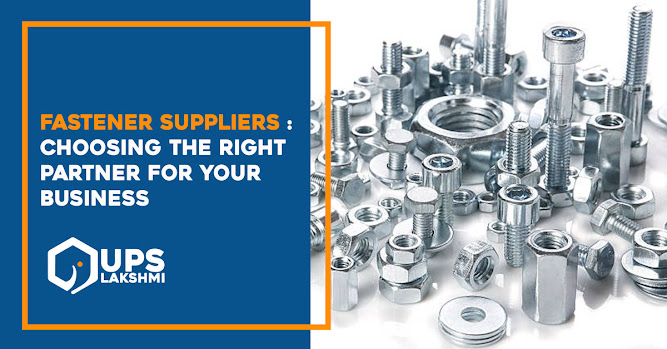What Are The Common Fastener Types?
A fastener is a tool that connects (or fastens or affixes) two or more objects. Fasteners are typically used to create non-permanent joints, or joints that can be removed or dismantled without causing damage to the joining components.
A welding joint or riveted joint is a permanent joint
that, if removed, tends to damage or destroy both the joining components as
well as the joint itself.
Mechanical fasteners are typically made of stainless
steel, carbon steel, or an alloy of the two. Mechanical fasteners come in a
variety of shapes and sizes and are used in a wide range of industries.
Some of them that are being used across industries are:
Bolts:
Bolts are mechanical fasteners that are used to join
two non-threaded components using a washer and nut. A bolt has a threaded end
and a head on one end. When the objects are fastened, the bolt holds them
together, and the washer and nut fasten from the other end, firmly holding them
together
The nut applies an axial clamping force to the joint,
while the plain, non-threaded length (called the shank) of the bolt pins the
joint against sideways shear stresses. The length of the non-threaded grip
should be roughly the same as the thickness of the material and washers through
which the bolt travels. An excessively long non-threaded length hinders the nut
from being properly tightened. Insufficient non-threaded length causes the
threads to extend into the hole, putting shear pressure on the threads and
perhaps causing hole wear. Within the hole, no more than two rounds of the
thread should be visible. Bolts include stud bolts, Hex fit bolts, Cylinderhead bolts, shoulder bolts, banjo bolts, and so on.
Screws:
Screws feature a head on one end and threads on the
other, similar to bolts. Screws, on the other hand, often have longer threads
than bolts and can even be produced with slotted heads. Screws are employed in
components that have their own thread or are cut with their own internal thread
by the screw. Screws fasten items by digging into and wedging into a substance
while the thread makes grooves in the secured material, which may help draw
fastened materials together and prevent pull-out.
A screw will almost always have a head on one end that
can be rotated with a tool. The head of the screw is normally larger than the
body, preventing the screw from being driven deeper than its length and
providing a bearing surface. The shank can be fully or partially threaded.
There are basically two types of screws:
Self-Tapping (also known as tap tite screws) are screws
that cut their own thread to secure thinner sheet metals and other substrates,
but normally require a predrilled or pre-punched hole
Self-drilling screw that can self-drill through a
variety of metal gauges without the need for predrilling.
Nuts:
Nuts are flat steel hexagonal items with internally cut
threads. Nuts are almost always used in conjunction with a mating bolt to
secure multiple pieces together. The two partners' threads and the compression
of the components that must be held together must be held together.
Hex, heavy hex, cap, and square nuts are among the many
types of nuts available, ranging from common household hardware to
sophisticated industry-specific designs that are built to fulfill various
technical standards.
Washers:
A washer is a thin plate with a hole (usually in the
middle) that is used to distribute the load of a threaded fastener, such as a
bolt or nut. Washers can also be used to reduce friction, prevent corrosion or
leaking, maintain tension, or act as a spacer. Hardened steel washers are
required in high-quality bolted joints to prevent pre-load loss owing to
persistent indentation after torque is applied. Washers help prevent galvanic
corrosion by isolating steel screws from aluminum surfaces.
Washers are divided into three categories:
Plain washers distribute the weight across a larger
area, reducing tension in the bolt and nut and limiting damage to the attached
surface
Spring washers have axial flexibility and are used to
prevent fastening or loosening caused by vibration.
A locking washer prevents the fastening mechanism from
unscrewing. Locking washers prohibit fastening or loosening.
Concrete Anchors:
A concrete anchor is a sort of heavy-duty fastener that
is used to attach items to concrete surfaces. The threaded end of the bolt is
frequently exposed because the head is normally immersed in concrete. Nuts are
used to secure the threaded end to the connecting object.
Anchor bolts are commonly used in foundations. They're
used to anchor and install structures and/or industrial equipment that need to
be durable and stable. Anchor bolts are most frequently used in concrete forms,
columns, foundations, and pads.
Rivets:
Rivets are a frequent type of permanent fastener. Rivets, unlike bolts and screws, cannot be removed. They primarily serve to keep plates or sheet metal in place.
Steel civic structures, aviation components, autos,
clothes, and ships all use rivets. Depending on the application, rivets are
used for a variety of purposes. As a result, there are many different types of
rivets, but solid rivets and pop rivets are the most common.
Universal Precision Screws is a leading manufacturer of
top quality industrial and commercial fasteners with a track record parallel to
none in the region. They are a one-stop shop for all your fastener needs, and
they don't just sell you the items you need, but they also offer comprehensive
technical support and advice to help you choose the right product for your
project.
Universal Precision Screws is proud to be able to say that they have been providing their customers with quality products since 2006, and they look forward to continuing this tradition into the future as well.




Comments
Post a Comment